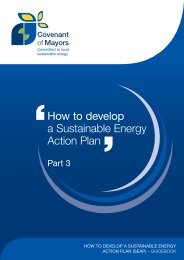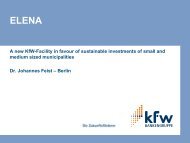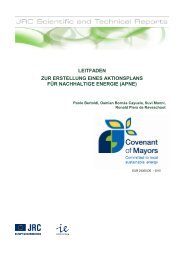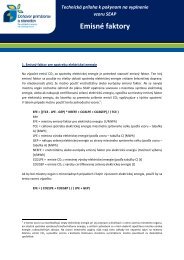English - Covenant of Mayors
English - Covenant of Mayors
English - Covenant of Mayors
You also want an ePaper? Increase the reach of your titles
YUMPU automatically turns print PDFs into web optimized ePapers that Google loves.
4.2.3 Rail transportation<br />
Rail transportation in the territory <strong>of</strong> the local authority can<br />
be divided into two parts:<br />
1. Urban rail transportation, for example tram, metro and<br />
local trains. The inclusion <strong>of</strong> this sector in the BEI is<br />
strongly recommended.<br />
2. Other rail transportation, which covers the longdistance,<br />
intercity and regional rail transportation that<br />
occurs in the territory <strong>of</strong> the local authority. Other rail<br />
transportation does not only serve the territory <strong>of</strong> the<br />
local authority, but a larger area. Other rail transportation<br />
includes also freight transport. These emissions can<br />
be included in the BEI if the local authority has included<br />
measures to reduce these emissions in the SEAP.<br />
The same methods can be used to estimate emissions <strong>of</strong><br />
both urban and other rail transportation.<br />
There are two types <strong>of</strong> activity data for rail transportation:<br />
consumption <strong>of</strong> electricity and consumption <strong>of</strong> fuel in<br />
diesel locomotives. Use <strong>of</strong> diesel locomotives in urban rail<br />
transportation is less common for local services.<br />
Number <strong>of</strong> providers <strong>of</strong> rail transport in the territory <strong>of</strong> the<br />
local authority is usually low. The local authority is recommended<br />
to ask the annual electricity and fuel use data<br />
directly from the service providers. If such data are not<br />
available, the local authority can estimate the emissions<br />
based on mileage travelled and average electricity or fuel<br />
consumption.<br />
4.3 Local electricity production<br />
(if applicable)<br />
Identification <strong>of</strong> local electricity production plants that are<br />
included in the BEI is explained in Section 3.4.2.<br />
For larger plants (such as CHPs), the data should be<br />
obtained via direct contact with the plant managers. For<br />
smaller units (domestic PV installations), the data can<br />
either be obtained through questionnaires or derived from<br />
statistics related to the amount <strong>of</strong> installations present in<br />
the territory <strong>of</strong> the local authority: number <strong>of</strong> permits<br />
delivered if such installations require a permit, number <strong>of</strong><br />
subsidies granted or regional/national statistics with<br />
a sufficient level <strong>of</strong> disaggregation.<br />
Market operators may also have data about entities that<br />
provide electricity to the grid and may help to identify them.<br />
All plants that are to be included in BEI/MEI should be<br />
listed in Table C <strong>of</strong> the SEAP template (see Annex II), with<br />
corresponding quantity <strong>of</strong> locally generated electricity,<br />
energy inputs, and corresponding CO 2<br />
emissions. Make<br />
sure that all energy used as an input for plants listed here<br />
is excluded from fuel consumption in Table A, in order to<br />
avoid double counting.<br />
4.4 Local heat/cold production<br />
Identification <strong>of</strong> local heat/cold production plants that are<br />
included in the BEI is explained in Section 3.5.<br />
The data should be obtained via direct contact (or<br />
questionnaires) with the plant managers, as mostly large<br />
units will be listed here. All plants that are to be included<br />
in BEI/MEI should be listed in Table D <strong>of</strong> the SEAP template<br />
(see Annex II), with the corresponding quantity <strong>of</strong> generated<br />
heat/cold, energy inputs, and corresponding CO 2<br />
emissions. Make sure that all energy used as an input for<br />
plants listed here is excluded from fuel consumption in<br />
Table A.<br />
Note: the case <strong>of</strong> micro cogeneration<br />
Micro cogeneration units may be too small, too numerous<br />
and scattered to obtain individual data about them. In<br />
such a case, the energy input <strong>of</strong> those units should be<br />
reported in Table A as final energy consumption, and<br />
consequently the heat and electricity produced should<br />
not be reported in Tables C and D. In addition, the electricity<br />
produced should not be accounted for as electricity<br />
consumption in Table A.<br />
On the contrary, if data are available (for example via<br />
support schemes, sales data from suppliers), then micro<br />
cogeneration units could be reported in Tables C and D,<br />
with the energy input and heat/electricity production data.<br />
4.5 Other sectors<br />
In the case <strong>of</strong> other sectors, the emissions <strong>of</strong> which are<br />
not related to fuel combustion, the local authority is recommended<br />
to use methodologies developed by specialised<br />
organisations. The local authority may consider using the<br />
methodologies <strong>of</strong> Local Governments for Sustainability<br />
(ICLEI) or Intergovernmental Panel on Climate Change<br />
(IPCC).<br />
The ICLEI’s International Local Government Greenhouse<br />
Gas Emissions Analysis Protocol (IEAP) is available at<br />
www.iclei.org/ghgprotocol<br />
The 2006 IPCC Guidelines are available at<br />
http://www.ipcc-nggip.iges.or.jp/public/2006gl/<br />
index.html<br />
25












